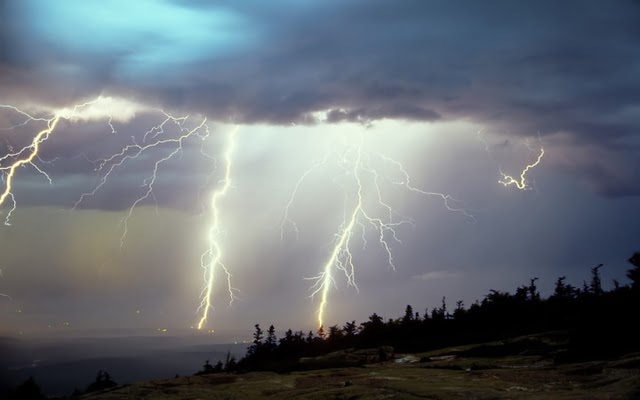Quck answer
When lightning strikes a tree, it can cause significant damage. The intense heat from the lightning can vaporize the tree’s moisture, leading to an explosion that splits the trunk or branches. The electrical current can travel through the tree’s sap, causing it to heat up and potentially start a fire. The impact of the lightning can also strip off bark and create deep cracks in the tree’s wood. These damages can weaken the tree’s structure and make it more susceptible to disease and infestation. In some cases, lightning strikes can even kill the tree instantly.

Kaboom! Pow! Bam! No, those are not the captions of animated fistfights. They are the sounds that often accompany thunderstorms.
When thunder is heard, it is natural to look for . . . lightning! Some may even count the seconds between thunder and lightning to determine its proximity. This can help gauge how close or far the lightning is.
What exactly is lightning? Simply put, it is a bright burst of electricity. It can happen within a single cloud, between clouds, and between a cloud and the ground. The latter, commonly referred to as cloud-to-ground lightning, is the lightning bolt we typically see during a thunderstorm.
What causes cloud-to-ground lightning? Small ice particles collide within thunderclouds, creating an electric charge. Objects on the ground, especially tall structures like mountains, buildings, trees, and even people, can also accumulate an electric charge. When these charges meet, they connect, and electric current rapidly flows from the cloud to the ground, resulting in a lightning strike.
Have you ever experienced static electricity? It has a similar cause. For instance, walking on a carpet builds up an electric charge. When you touch a metal object, you may feel a shock! This is static electricity moving between you and the object.
A flash of lightning is only a few inches wide, but it appears much larger to the human eye. It can also be extremely dangerous, even lethal. There is a significant amount of electricity in a lightning flash, and it is also very hot. A single bolt can reach temperatures of about 54,000º F, which is approximately six times hotter than the Sun’s surface!
So, what happens when that powerful lightning bolt strikes an object on Earth? Specifically, what happens when lightning hits a living tree? The type of tree, its overall health, and the amount of moisture it contains all influence how the tree is affected. Of course, the intensity of the lightning itself also plays a role.
Most of the damage occurs when the moisture inside the tree encounters the extremely high temperatures caused by lightning. A tree’s moist tissues are usually located just below the outer layer of bark. This is why some lightning strikes cause the bark of a tree to appear as if it has exploded in large pieces.
If the outer layer of bark is saturated from heavy rain, the lightning may travel along the tree’s exterior to the ground, resulting in minimal damage. However, in other cases, intense lightning bolts can split trees in half and cause them to ignite from the inside out.
A tree struck by lightning may survive for many years. Others may need to be cut down if they pose a risk of falling on people or property. Some large trees have been struck by lightning multiple times.
If a tree hit by lightning does not catch fire and burn completely, it may survive for a considerable amount of time with its injuries. However, lightning-damaged trees are often more vulnerable to damage from insects, disease, and decay.
Have you ever witnessed a tree that has been hit by lightning? What about other objects? Lightning may pose a danger, but it is also a fascinating weather phenomenon! Now you will learn about the causes of these brilliant flashes of light during the next thunderstorm.
Give It a Try
Wow! Wasn’t today’s Wonder of the Day surprising? Find a friend or family member to assist you in exploring one or more of the following activities:
- Have you ever observed a tree that has been struck by lightning? A hike through a nearby forest will likely reveal multiple examples of trees that have been struck by lightning. If you are unsure what to look for, take a look at this photo gallery of lightning-struck trees. Do the trees resemble what you imagined? Why or why not? How can you identify a tree that has been struck by lightning? Discuss with a friend or family member.
- Despite its potential for destruction, lightning is undeniably one of nature’s most beautiful phenomena. Due to its unpredictable nature, capturing lightning strikes in photographs can be challenging. Many photographers, both amateur and professional, have spent significant time attempting to capture incredible photos of lightning strikes. Visit The Photo Argus to see some of the best examples we have found! What photography techniques result in the best lightning pictures? Which images are your favorites, and what do you appreciate about them? Write a letter or email to a friend or family member sharing what you have learned and your thoughts on these photos.
- Can you recall the most recent major storm in your area? Was there a significant amount of lightning? How loud was the thunder? Did the storm cause any damage? Did anything get struck by lightning? Share your memories and thoughts about the storm with a friend or family member.
Sources of Wonder
- https://agrilife.org/treecarekit/after-the-storm/understanding-lightning-associated-tree-damage/ (accessed 07 June 2021)
- https://gatrees.org/wp-content/uploads/2020/02/Lightning-Struck-Trees.pdf (accessed 07 June 2021)





Leave a Reply